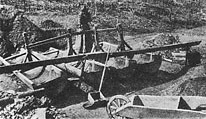North
Carolina
Business
History
America's first gold rush was in North Carolina. The discovery of gold in 1799 in Cabarrus County and subsequent gold mining successes in the 1820s and 1830s made the state the leading producer of gold in the U.S. until 1849 and the California gold strike (1848).





Gold mining was a leading occupation (behind agricultural) in the late 1820s and early 1830s. North Carolina became known as the "Golden State," an appellation it retained until displaced by the California Gold Rush beginning in 1848.
"The gold mines of North Carolina have lately excited
 much interest,
and with those of other southern States, are becoming an object of
national importance. The number of persons engaged in mining operations in
the whole of the gold district, is estimated at upwards of 20,000; the
weekly product of all the mines is supposed to be $100,000, or about 5
millions of dollars annually; but a small portion of this, however, is
sent to the United States' mint, or remains in the country: the greater
part is exported to Europe, particularly to Paris."
much interest,
and with those of other southern States, are becoming an object of
national importance. The number of persons engaged in mining operations in
the whole of the gold district, is estimated at upwards of 20,000; the
weekly product of all the mines is supposed to be $100,000, or about 5
millions of dollars annually; but a small portion of this, however, is
sent to the United States' mint, or remains in the country: the greater
part is exported to Europe, particularly to Paris.""In this State, the gold mines are principally in the counties of Burke, Rutherford, Mecklenburg, Rowan, Davidson, and
 Cabarrus;
in almost any part of this district, gold may be found in greater or less
abundance mixed with the soil," according to Mitchell's Reference and Distance Map
of the United States (1835).
Cabarrus;
in almost any part of this district, gold may be found in greater or less
abundance mixed with the soil," according to Mitchell's Reference and Distance Map
of the United States (1835).One of the leading businesses was the Bechtler Mint (gold assay and mint), which provided certified minted coins (sample pictured at right) of weight and purity of the melted North Carolina gold. Christopher Bechtler established his mint at Rutherfordton in 1831. Bechtler minted $2.50 and $5 coins, followed in 1832 with the nation's first $1 gold coin. The Bechtler mint continued until 1857, with his son running operations after 1842 when Christopher died.
The U.S. Congress authorized creation of a Charlotte Mint in 1835 to mint gold coins. The Charlotte Mint opened in December 1837.
The financial panic of 1837 hit the mining industry hard. Firms went dormant or bankrupt. But over the 10 year period (1838-1847), North Carolina mines still produced an average of more than 14,000 troy ounces of gold annually with a value of $289,000.
In 1848, California produced $245,000 worth of gold. But by 1850, California dwarfed Southern states by producing $41 million. California gold mining peaked in 1852 with $81 million and slide to $45 million in 1857.
After the Civil War, gold mining resumed in North Carolina although it never returned to pre-war levels. Some gold was mined well into the 1900s.
| Troy Oz. | Value (current $) | |
| 1804-1823 | 2,274 | $47,000 |
| 1824 | 242 | 5,000 |
| 1825 | 822 | 17,000 |
| 1826 | 968 | 20,000 |
| 1827 | 1,016 | 21,000 |
| 1828 | 2,225 | 46,000 |
| 1829 | 6,483 | 134,000 |
| 1830 | 9,869 | 204,000 |
| 1831 | 14,224 | 294,000 |
| 1832 | 22,158 | 458,000 |
| 1833 | 22,980 | 475,000 |
| 1834 | 18,384 | 380,000 |
| 1835 | 12,724 | 263,000 |
| 1836 | 7,165 | 148,000 |
| 1837 | 5,656 | 116,900 |
| 1838-1847 | 140,232 | 2,898,505 |
| 1848 | 22,910 | 473,543 |
| 1849 | 23,502 | 485,793 |
| 1850 | 17,200 | 355,523 |
| 1851 | 15,814 | 326,883 |
| 1852 | 19,512 | 403,295 |
| 1853 | 13,334 | 275,622 |
| 1854 | 10,018 | 207,073 |
| 1855 | 10,954 | 226,416 |
| 1856 | 8,276 | 171,070 |
| 1857 | 4,058 | 83,870 |
| 1858 | 9,325 | 192,742 |
| 1859 | 10,381 | 214,574 |
| 1860 | 7,556 | 156,182 |
| 1861-1865 | 1,620 | 33,497 |
| 1866 | 6,818 | 140,937 |
| 1867 | 3,208 | 66,306 |
| 1868 | 4,350 | 89,906 |
| 1869 | 5,645 | 116,672 |
| 1870 | 4,892 | 101,111 |
Industries
Laureates Contact
Us Home
2006 Copyright. CommunicationSolutions/ISI
for web site and content.